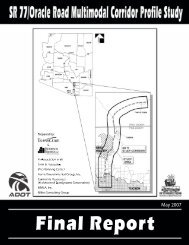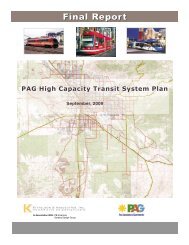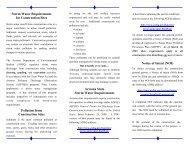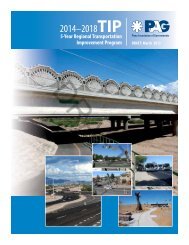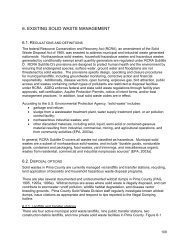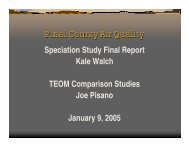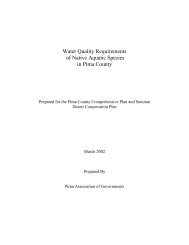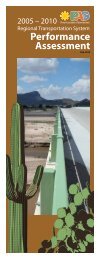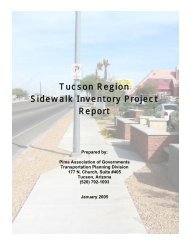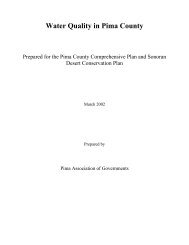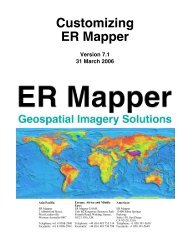Overall Work Program - Pima Association of Governments
Overall Work Program - Pima Association of Governments
Overall Work Program - Pima Association of Governments
You also want an ePaper? Increase the reach of your titles
YUMPU automatically turns print PDFs into web optimized ePapers that Google loves.
Regional Planning<br />
Background and Overview<br />
Created in 1970 by the Arizona Legislature, <strong>Pima</strong> <strong>Association</strong> <strong>of</strong> <strong>Governments</strong> (PAG) is a nonpr<strong>of</strong>it regional<br />
planning organization that serves member jurisdictions located in <strong>Pima</strong> County, Arizona. PAG's authority is<br />
derived from federal and state laws and from intergovernmental agreements. PAG facilitates coordination,<br />
cooperation, data development, information sharing and sound decision-making related to issues that cross<br />
jurisdictional boundaries, such as air quality, water quality, transportation, urban growth and human services,<br />
using a continuous, comprehensive and collaborative planning process that involves elected <strong>of</strong>ficials, agency<br />
staff, key stakeholders, interest groups and the general public.<br />
PAG was federally designated in 1973 as the metropolitan planning organization (MPO) for transportation<br />
planning in <strong>Pima</strong> County. PAG also was designated by the Arizona Governor to serve as the principal planning<br />
agency for air quality and water quality planning in the region. In addition, pursuant to an Executive Order<br />
from the Governor, PAG develops population estimates and projections for jurisdictions in the region.<br />
In 2004, the PAG region established, through enabling state legislation (ARS 48-5302), a Regional<br />
Transportation Authority (RTA). The state legislation charged the RTA with the development <strong>of</strong> 20-year<br />
regional transportation plan that was to be presented to the voters for approval along with a request for<br />
approval <strong>of</strong> up to a ½-cent transaction privilege tax to fund the plan. The RTA plan and supporting ½-cent<br />
transaction privilege tax were both approved by <strong>Pima</strong> County voters on May 16, 2006, and will continue until<br />
FY 2026. The RTA plan is a component <strong>of</strong> the PAG Regional Transportation Plan.<br />
Regional Planning Structure<br />
PAG is governed by a Regional Council comprised <strong>of</strong> one elected <strong>of</strong>ficial from each <strong>of</strong> its eight member<br />
jurisdictions (<strong>Pima</strong> County, City <strong>of</strong> Tucson, City <strong>of</strong> South Tucson, Town <strong>of</strong> Marana, Town <strong>of</strong> Oro Valley, Town <strong>of</strong><br />
Sahuarita, Tohono O'odham Nation and Pascua Yaqui Tribe) and the <strong>Pima</strong> County member <strong>of</strong> the Arizona State<br />
Transportation Board.<br />
The PAG Management Committee consists <strong>of</strong> the chief administrative <strong>of</strong>ficer <strong>of</strong> each member jurisdiction. The<br />
PAG Management Committee provides specific policy and technical recommendations to the PAG Executive<br />
Director, who forwards them to the Regional Council for consideration and action.<br />
Several standing committees have been established to provide recommendations to the PAG Management<br />
Committee and Executive Director for forwarding to the Regional Council. These committees are generally<br />
comprised <strong>of</strong> agency staff, representatives <strong>of</strong> community, business and environmental groups, and citizens.<br />
In addition, PAG uses numerous ad hoc subcommittees, task forces and working groups comprised <strong>of</strong> a<br />
diversity <strong>of</strong> stakeholders, ranging from elected <strong>of</strong>ficials and technical and pr<strong>of</strong>essional experts to lay citizens.<br />
These ad hoc working groups are used for gathering a variety <strong>of</strong> viewpoints on a wide range <strong>of</strong> regional<br />
planning topics and issues.<br />
PAG's Executive Director serves as the agency's chief executive <strong>of</strong>ficer. Under appointment and general<br />
guidance <strong>of</strong> the Regional Council, the Executive Director is responsible for all regional planning and<br />
administrative functions, including intergovernmental consultation, cooperation and coordination <strong>of</strong><br />
programs. The Executive Director directs PAG staff in the development and implementation <strong>of</strong> the annual<br />
<strong>Overall</strong> <strong>Work</strong> <strong>Program</strong>. PAG’s Organization Chart is provided in Appendix A.<br />
<strong>Overall</strong> <strong>Work</strong> <strong>Program</strong><br />
PAG’s comprehensive regional planning program is implemented through PAG's <strong>Overall</strong> <strong>Work</strong> <strong>Program</strong> (OWP).<br />
Member jurisdictions look to PAG to provide a regional context for actions taken by federal, state and local<br />
government agencies. PAG uses an inclusive, consensus-building approach to address issues related to future<br />
growth, development and quality <strong>of</strong> life in the region.<br />
PAG's work program is largely developed and implemented through a cooperative inter-agency process<br />
<strong>Pima</strong> <strong>Association</strong> <strong>of</strong> <strong>Governments</strong> 1 June 28, 2012



